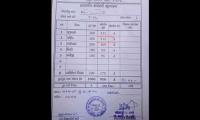KARACHI: The country’ financial sector reported an upsurge in real economic growth during the outgoing fiscal year of 2016/17 due to an increase in business volumes and banks’ profits and other financial intermediaries, Economic Survey 2016/17 showed on Thursday.
“Financial service output in 10 months to April was 10.77 percent higher than a year earlier,” it revealed. Financial sector grew 6.12 percent during the same period of the last fiscal year.
The survey said rapid expansion of deposit formation and demand for loans gave a boost to finance and insurance activities. Bank deposits grew 15 percent, while advances were 11 percent in July-April FY17.
Finance and insurance accounts for 5.7 percent of services sector and its share in gross domestic product was 3.37 percent in FY17.
Finance and Insurance comprises the State Bank of Pakistan; all scheduled Banks (domestic and foreign), Development Financial Institutions (DFIs), all Insurances companies, modaraba/leasing companies, money changers and Stock Exchange Brokers.
“The services sector recorded a growth of 5.98 percent in FY17 and surpassed its target which was set at 5.70 percent,” the survey said.
Analysts said the financial sector’s share of economic activity continued to rise as low interest rates encouraged banks to improve accesses to finance for businesses and consumers.
“An accommodative monetary policy stance; increase in development spending; substantial growth in private sector credit, especially for fixed investment; and ongoing CPEC-inspired activity in power sector and infrastructure are pointing to pick up in economic growth,” said an analyst.
Pakistan’s banking sector, a top contributor to the national exchequer, paid Rs140 billion in taxes, while it also collected over Rs 134 billion as withholding tax in last year. Therefore, the total contribution to the exchequer from banks was over Rs274 billion.
The survey said the alignment of the regulatory capital requirements in Pakistan with best international practices coupled with high profitability has helped achieving strong solvency. “The Capital Adequacy Ratio (CAR) of 16.2 percent as of end December 2016 was much stronger and higher than the minimum required level of 10.65 percent,” it added.
Financial sector reforms have improved the access to finance, especially for small and medium enterprises through implementation of the National Financial Inclusion Strategy and legislative measures. The government has considered the financial inclusion strategy as a key policy agenda for inclusive economic development.
In order to achieve NFIS objectives/goals relating to digital payments, credit for microfinance and SME risk sharing, the government has approved a development funded projects for an amounted $137 million to be implemented in five years with World Bank assistance.
The banking sector’s profitability rose 18.9 percent to Rs33.3 billion in first quarter of 2017. The increase in earnings was attributed to capital gain realisation, significant reduction in provisioning costs and containment in administrative expenses. “Banking sector’s profitability is likely to face some reduction in anticipation of some measures being announced by the government in the FY18,” the survey said.
The government is considering to extend super tax in FY18, but at a higher rate of five percent. This would reduce the profitability of banks. Further, another change the FBR is mulling is withdrawing the 7th schedule which allows banks certain benefits. This measure would nominally impact the effective tax rate of banks although it might impact capital adequacy ratio.
The picture shows the building of the Securities and Exchange Commission of Pakistan . — The News/FileISLAMABAD:...
A view of a Shell petrol pump with bikers waiting at the fuel station. — Online/FileKARACHI: Shell Pakistan Limited ...
A representational image shows Total Energies employees walking in the Donges oil refinery in Donges, on September 8,...
An undated image of gold bars. — AFP/FileKARACHI: Gold prices in the local market dropped by Rs800 per tola on...
Sweden’s central bank building seen in this undated photo.— Bloomberg News/File Oslo/Frankfurt/London: Sweden’s...
People buy pulses and grains at a wholesale market. — AFP/FileLAHORE: The institutions in developed economies ensure...







